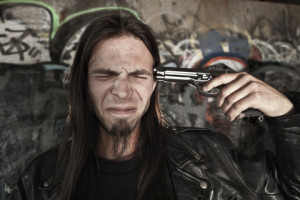When you pull the addiction trigger, the disease of addiction fires off addictive thinking, automatic addictive or drug seeking behavior, and a craving or urge that pulls you toward high risk situations. (Terence Gorski)
The term “trigger event” is used to describe what turns on the addictive thinking, drug seeking behavior, or the craving (a strong need or drive) to be involved in high risk situations (See “The Yin-Yang of High Risk Situations”). Using the metaphor of a loaded gun, Gorski said addiction in early recovery is very much like holding a loaded gun—with a hair trigger.
The problem is that events and circumstances act as powerful triggers for some people, while they have no effect on others. What can be even more confusing is that some days a circumstance can activate a powerful trigger. But on other days the same situation does nothing to pull the trigger and activate the craving.
Mistakenly, triggers are often seen as only external to the person. So the focus in managing triggers becomes one of identifying and avoiding external situations related to drug use and drinking. But triggers can be internal as well as external. Gorski defined a trigger event as “any internal or external occurrence that activates a craving (obsession, compulsion, physical craving, and drug-seeking behavior).” By internal occurrences he means thoughts or feelings. External occurrences involve the five senses: sight, sound, smell, taste and touch.
For these events to become triggers, they have to be connected to the person’s use of alcohol or drugs. The trigger is stronger if the event happened just before or while using. This is what makes needles, when drawing blood, a trigger to the IV drug user. Years ago I knew someone who couldn’t listen to “The Wall” by Pink Floyd in early recovery because he always did so before when he was high.
Gorski then said there were three phases in “disempowering” a trigger. Phase 1 was Avoidance. Here the person is to make a list of the most powerful triggers associated with his using and avoided them. The ubiquitous recovery mantra to avoid people, places and things (PPT) associated with addiction fits here.
The second phase was to gradually re-introduce some “trigger” events, along with good recovery support. This would not include returning to a bar where you used to drink. But it could mean going to a restaurant or party where alcohol will be served. There could be a local bar and grill that is known for its wings. Going there in early recovery is not a good idea, but with support later on might be acceptable. Maybe try getting takeout a few times first.
Alcohol is such a part of our society, total avoidance would mean a very sheltered and limited life. “Therefore, in order to lead any kind of normal life, gradual introduction is necessary.” There is an Italian restaurant, with an attached sports bar near a local N.A. meeting. After the meeting, some members go there for pizza; others don’t. This gradual re-introduction is just that—GRADUAL. And it shouldn’t be practiced when the person’s sobriety is unstable. Stress or instability in sobriety means that phase 1 avoidance should be instituted.
The third phase is extinction, meaning that the using trigger’s ability to activate a craving is eliminated or extinguished. A woman habitually sat in one particular barstool at home when she drank. In early recovery she learned to avoid sitting there, because it activated her “stinking thinking.” Through repeated times of sitting in the barstool when doing other things like drinking her morning coffee and reading a book, paying her bills, etc. she extinguished sitting in the barstool as a trigger event of her cravings to drink.
This is a process of retraining your mind or desensitizing it to what used to be stimuli (triggers) to get high. You may recognize the principles of operant and even classical conditioning incorporated within Gorski’s process of disempowering triggers. But these principles alone aren’t always enough to bring about successful extinction of a trigger. The above comments drawn from Gorski’s article suggested this—when the sporadic nature of some triggers was mentioned. “Without a clear understanding of the psychobiological dynamics of a trigger event, the only way to learn to [manage] them is through trial and error.” Why is this?
I’d suggest that humans are psychosomatic unities of body (soma) and soul (psyche). See another article, “We Are But Thinking Reeds,” for greater discussion of this concept. Existing within the soul are not only the internal events of thoughts and feelings, but deeper desires, wants and loves. In recovery you see this expressed by the phrase “I want what I want.” The ‘psychobiological dynamics’ of a trigger event engages these desires as well as the thoughts and feelings.
Disempowering triggers can extinguish the reinforcement pattern of the thoughts and feelings to the external event, but they cannot eradicate the deep desires. One of these desires is the “loaded gun” of wanting to get high. Here is where self-control in recovery comes in—learning to not act on the thoughts and feelings that stem from it; not giving into the desire to get high. At best, this desire will go into hibernation. Practicing a program of recovery will help keep it there.
I have read and used Terence Gorski’s material on relapse and recovery for most of my career as an addictions counselor. I’ve read several of his books and booklets; and I’ve completed many of his online training courses. He has a blog, Terry Gorski’s blog, where he graciously shares much of what he has learned, researched and written over the years. This is one of a series of articles based upon the material available on his blog and website.

